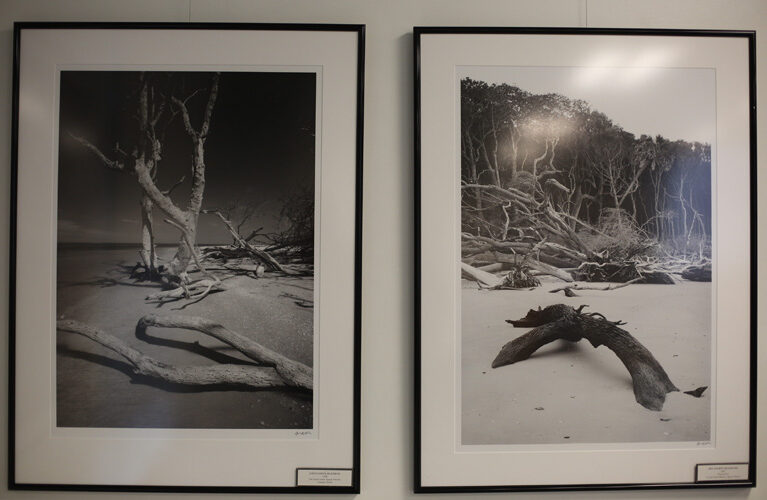
Often referred to as Florida’s Ansel Adams, Clyde Butcher is legendary for his ability to capture the essence of Florida landscapes with his large-scale, black-and-white photography. Butcher’s works also highlight the spiritual side of nature from some of its more remote locations.
A lesser-known collection of his photographs, “Florida Aquatic Preserves,” is on display through Feb. 28 at the Environmental Learning Center.
Butcher had donated the collection of 29 photos, taken in the aquatic preserves that dot the Florida coastline, to the Department of Environmental Protection many years ago, where it remained hidden away in storage. It was only recently recovered for display.
“We are so fortunate to have been loaned this exhibit,” says Barbara Schlitt Ford, ELC executive director.
It was during an eco-talk presentation at the ELC by Emily Dark of the Florida DEP office of Reliance and Coastal Protection, that Dark mentioned the rediscovered photos.
“Afterwards, I asked her if we might be able to acquire them to show at our campus, since it aligned perfectly with our mission to educate, inspire and empower all people to be active stewards of the environment and their own well-being,” says Ford. She said yes, and now they are here. This is the first time these photos have ever been displayed in this area.”
Florida is home to 41 aquatic preserves, the finest of which have been set aside for protection under the Aquatic Preserve Act enacted in 1975. This has ensured that the aesthetic, biological and scientific values of these coastal landscapes will provide wildlife habitats, as well as recreational and cultural values for many generations.
The collection on display is a visual journey through those preserves, from the twisted cypress trees of the Wekiva River, to the windswept beaches of Cayo Costa and the swaying grasses beneath the crystal-clear waters of Rainbow Springs.
The stark solitude of a lone mangrove island protruding from the sea is shown in sharp contrast to the dense jungle canopy of an Everglades swamp. And Butcher has captured a mirror reflection of clouds on Charlotte Harbor with such perfection that it is possible to hang the photograph upside down and it will still look the same.
From the sandy dunes of St. Joseph Bay to the untamed wilderness of the Sebastian River Buffer Preserve, Butcher’s photos encapsulate the unique diversity and grandeur of Florida’s indigenous landscape.
The collection is captivating in its size and magnitude, easily illustrating the reason Butcher is ranked as one of the foremost landscape photographers in America today.
Like all of his work, the photos are shot in a large camera format to capture the enormity of the scenes. Butcher prefers to use the largest film possible to portray the entirety of the vista and to enable viewers to feel as if they are walking into the scene.
An avid conservationist, Butcher feels compelled to educate the public through his documentaries and photography. He selected the 29 photos of the ‘Living Waters’ exhibit to complement a PBS film series he had completed on the fragility of Florida’s ecosystems.
“So many people have no idea what and where the aquatic preserves are,” Butcher explains in a telephone interview from his home in Venice, on Florida’s Gulf Coast.
“These are protected watersheds, and as aesthetically beautiful as they are, they are scientifically crucial to the preservation of clean water. We all have to do more to preserve our environment. If Florida is to survive in the future, we have to be careful about how much development we allow on the water’s edge, where it destroys our estuaries.
“But this is not just a Florida issue. The world is round, and what everyone in every country is doing makes a worldwide impact. Unless we look at the big picture and what everyone is doing in every part of the world, we are going to lose our precious resources.”
Although trained in architectural design, it was during a visit to an Ansel Adams photography exhibit at Yosemite National Park with wife Niki, that Butcher first discovered his true calling. He initially began selling his black-and-white photographs at art festivals, and later founded Eye Encounter, selling his works to department stores as wall décor.
When the stress of what developed into a multimillion-dollar business became too much, he sold it and moved his family to Florida. There, a whole new world – one filled with swamps and backwaters – opened up to him.
Butcher sets about capturing moments in time, often sitting for hours or days at a time until nature dictates the right instant to shoot. Portraying that precise moment when light, shadows and landscape combine in perfect harmony is his legacy.
“It’s all about patience and persistence,” says Butcher. “I do a lot of thinking while I’m waiting for the perfect light. Nature is where I find solace in this ever-changing world.”
The primeval beauty of the Everglades is so extraordinary that Butcher once said the he has sometimes been asked what country he had been in when he took the photos. That helped reinforce to him the importance of educating the populace about Florida’s diverse native habitat.
Today, with the Myakka River State Park almost in his backyard, Butcher continues to spend his days capturing the beauty of the vast expanse of unspoiled wetlands, prairies and hammocks.
The “Florida Aquatic Preserves” exhibit, on display through the end of February, is included in the cost of admission to the ELC. For more information, visit DiscoverELC.org.



